GEOLOGY HAPPENINGS August 2021 |
| The Morrison Formation: The Big Picture By Allyson Mathis |
This is the first of two columns the Morrison Formation, which is one of the most iconic rock layers in the American west. Next month’s column will focus more specifically on the Morrison in the Moab area.
 |
| Allosaurus atrox at the Cleveland-Lloyd Dinosaur Quarry in Jurassic National Monument. Photo by John St. James, Creative Commons CC BY 2.0 |
The Moab area is richly endowed with one of the most comprehensive rock records of the Mesozoic Era in North America. Colloquially, the Mesozoic (“middle life”) is known as the Age of the Dinosaurs, and specimens of many important species, Allosaurus, Apatosaurus, Utahraptor, and Moabosaurus to name a few, have been found in one of the rocks layers present in southeastern Utah. Moab is also abundantly blessed by being centered in one of the most scenic areas in the country with grand exposures of colorful rock layers in a tableau of cliffs and slopes, as well as in rounded rock domes and rounded hills. Thirdly, Southeastern Utah’s human history has a direct tie to its geology, including significant deposits of uranium, copper, oil and gas and other mineral resources.
The Morrison Formation has a role in all three of these aspects of Moab’s geologic story. The unit is best known for its dinosaur fossils and many important specimens have been collected in southeastern Utah. Its candy-striped hills add a rainbow of rich colors to the red-rock landscape, and many significant deposits were mined during the uranium boom.
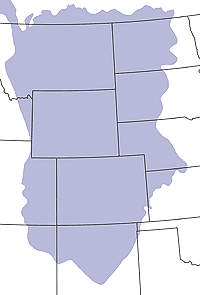 |
| Map showing the area of the Morrison Formation. |
Near Moab, the Morrison Formation consists of ledgey sandstones that make for fun riding in the Klondike and Brands mountain biking areas, and forms colorful hillslopes north of Moab near the Dalton Wells Road and adjacent to the Delicate Arch trailhead.
But the Morrison Formation near Moab is only a small part of a rock layer (a formation to geologists) the covers vast territories in the west. The Morrison extends across a very wide geographic area ranging from northern Arizona and New Mexico north to southern Canada, encompassing an area totalling 1.5 million square miles.
The Morrison Formation is named for Morrison, Colorado, a small town just west of Denver in the foothills of the Front Range where geologists first described it. The Morrison is somewhat variable throughout its geographic area, but it largely consists of sediments deposited in a continental basin containing rivers, floodplains, lakes, and wetlands. The Morrison basin was bounded on the west by a volcanic mountain range in what is now Nevada. Rivers draining these highlands flowed west to east into the Morrison basin, and volcanic ash was carried in on wind currents from massive volcanic eruptions that also took place in the western uplands. The northern part of the Morrison basin bordered the Western Interior Seaway, and some sediments deposited under marine conditions are present in the unit.
Across the entire area that the Morrison was deposited, the rock unit records geographic variations within the region. Some of these variations produced distinctive members (subdivisions) of the Morrison Formation such as the eponymous Bluff Sandstone. The Bluff Sandstone was deposited in a small area of sand dunes in far southeastern Utah. These sand dune deposits now form distinctive cliffs above the small town and along the San Juan River.
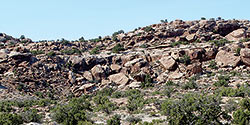 |
| The Morrison Formation near the Klondike Bluffs trails system |
The Morrison Formation was deposited between 150-157 million years ago during the latter part of the Jurassic Period. The climate in the Morrison basin was mostly semi-arid. Water flowed into the basin from the western highlands via rivers and as groundwater. Despite the relatively dry climate, the area had a high water table as evidenced by the numerous lakes that dotted the landscape.
Although nearly-complete dinosaur skeletons are known from large quarries in the Morrison such as the Carnegie Quarry in Dinosaur National Monument and the Cleveland Lloyd Dinosaur Quarry in Jurassic National Monument, individual bones and bone fragments are much more common in the unit as a whole. Bone fragments can be found in sandstones that deposited in stream channels. Dinosaur trackways are also known from the Morrison Formation. Other types of fossils found in the Morrison including those of freshwater bivalve mollusks, petrified logs and other plant fossils, pollen, and insects.
Special thanks to Jim Kirkland and John Foster.
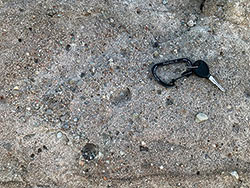 |
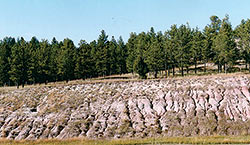 |
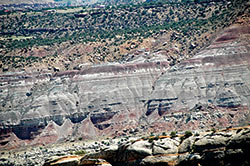 |
| Pebbly sandstone that was deposited by fast currents in a Morrison stream channel. | The Morrison Formation in the Black Hills in Wyoming. Photo courtesy of John Foster. |
The Morrison Formation near Fruita, Colorado. Photo by John St. James, Creative Commons CC BY 2.0 |
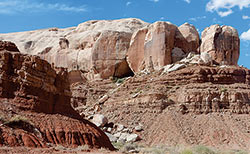 |
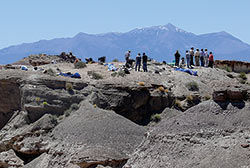 |
|
| The Bluff Sandstone, a member of the Morrison Formation, just north of the town of Bluff, Utah. Photo by Kent G. Budge, Creative Commons CC0 1.0. |
An excavation at the Burpee Dinosaur Quarry near Hanksville. The Hanksville-Burpee Quarry may be the largest single dinosaur site in North America. The bonebed is on top of a large gravelly river system. Photo courtesy of Jim Kirkland. |